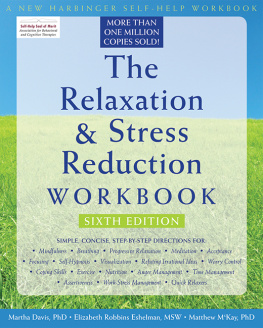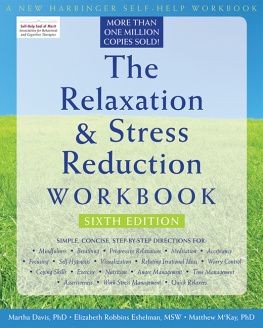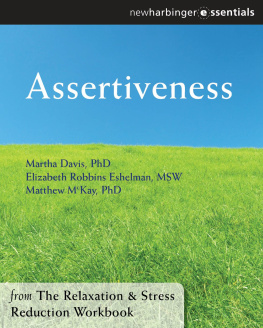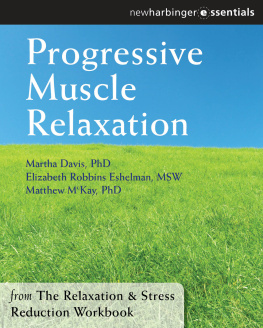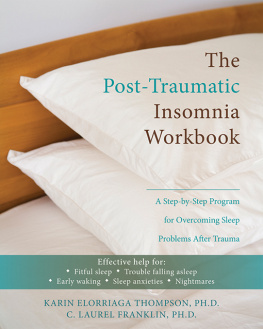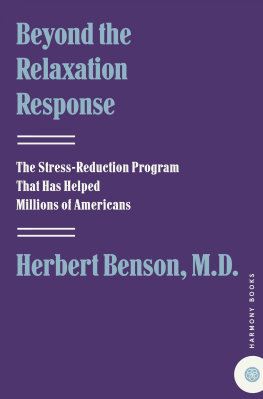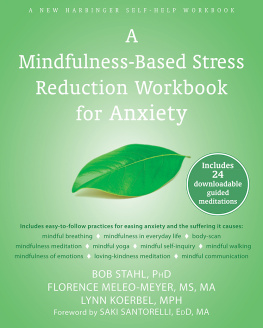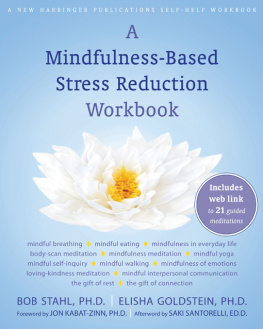Publishers Note
This publication is designed to provide accurate and authoritative information in regard to the subject matter covered. It is sold with the understanding that the publisher is not engaged in rendering psychological, financial, legal, or other professional services. If expert assistance or counseling is needed, the services of a competent professional should be sought.
The material in chapter 13 that is based upon the work of Michelle G. Craske and David H. Barlows Master Your Anxiety and Worry, 2nd ed. (2006) pages 99109 is used by permission of Oxford University Press.
Distributed in Canada by Raincoast Books
Copyright 2008 by Martha Davis, Elizabeth Robbins Eshelman, and Matthew McKay
New Harbinger Publications, Inc.
5674 Shattuck Avenue
Oakland, CA 94609
www.newharbinger.com
All Rights Reserved
ePub ISBN: 9781608820702
Acquired by Tesilya Hanauer; Cover design by Amy Shoup;
Edited by Kayla Sussell
The Library of Congress has cataloged the print edition as:
Davis, Martha, 1947
The relaxation and stress reduction workbook / Martha Davis, Elizabeth Robbins Eshelman, and Matthew McKay. -- 6th ed.
p. cm.
Includes bibliographical references and index.
ISBN-13: 978-1-57224-549-5 (pbk. : alk. paper)
ISBN-10: 1-57224-549-2 (pbk. : alk. paper) 1. Stress management. 2. Relaxation. I. Eshelman, Elizabeth Robbins. II. McKay, Matthew. III. Title.
RA785.D374 2008
616.98--dc22
2008003637

Praise for The Relxation and Stress Reduction Workbook:
This comprehensive workbook deserves to be in the library of every active therapist, but it shouldnt be left on the shelf! Once again, the authors have empowered the reader with straightforward instructions on every major approach to stress management known. From worry to chronic headaches to information overload, here is your one-stop guide to recovery.
R. Reid Wilson, Ph.D., author of Dont Panic: Taking Control of Anxiety Attacks
This text remains, after twenty years, the clearest, best-organized, and most readable book on stress management. It has achieved the status of the classic self-help reference in the field.
Edmund J. Bourne, Ph.D., author of The Anxiety and Phobia Workbook, Coping with Anxiety, and Beyond Anxiety and Phobia
An exemplary book on stress. It is lucidly written, rationally ordered, and comprehensive, and each section is densely packed with instructions and exercises which make the workbook easy to practice.
Somatics Magazine: Journal of the Mind/Body Arts and Sciences

Self-Hypnosis
In this chapter you will learn to:
- Use self-suggestions for deep relaxation and positive change
- Fight stress and stress-related illnesses
- Alleviate specific problems such as insomnia
Background
Hypnosis is a term derived from the Greek word for sleep. In some ways, hypnosis is similar to sleep: there is a narrowing of consciousness accompanied by inertia and passivity. Hypnosis is very relaxing. But unlike sleep you never completely lose awareness during hypnosis. While hypnotized, you are able to respond to things going on around you. Although hypnosis is usually done with eyes closed to facilitate concentration and imagination, it also can be done with the eyes open.
Hypnosis allows you to experience your thoughts and images as real. While you are hypnotized you willingly suspend disbelief for the moment, just as you do when you become absorbed in a compelling fantasy or play. For instance, when you watch a violent chase scene in a movie, your mind and body respond in many ways as though you were actually participating in the chase: your muscles tense, your stomach churns, your heart rate increases, and you feel excited or scared. The brain-wave patterns traced on an electroencephalogram (EEG) during hypnosis resemble the patterns that typically occur during the actual activities that the hypnotized person is imagining (participating in a chase, relaxing at the beach, playing a musical instrument, and so on).
You may think that you have never been hypnotized but, in fact, you are no stranger to hypnosis. Often, when you concentrate on something of great interest to you, you enter hypnosis without any formal induction. Daydreaming, for example, is a hypnotic state. Long-distance driving is highly conducive to hypnosis (and commonly results in amnesia for various parts of the trip). You may have entered a form of light hypnosis many times while trying to remember a shopping list, a past sequence of events, or while watching TV and feeling a strong emotion such as fear.
In this chapter you will learn to use self-hypnosis to experience positive thoughts and images of your own choosing for the purpose of relaxing and reducing stress. You can learn self-hypnosis quickly and safely. There are no reported cases of harm resulting from self-hypnosis. Because hypnosis is your experience of your own thoughts and images, it can take place only when your participation is active and voluntary. (This is true even when you are undergoing hypnotic induction by someone else.) You can extend, modify, or shorten any of the hypnosis exercises in this chapter to meet your specific needs.
Symptom-Relief Effectiveness
Self-hypnosis has been clinically effective with symptoms of insomnia, minor chronic pain, headache, nervous tics and tremors, chronic muscular tension, and minor anxiety. It is a well-established treatment for chronic fatigue. You may also consider using self-hypnosis for any subjective experience that could be improved with positive words and images (for example, the rapid heartbeat, cold sweaty palms, and knotted stomach associated with anticipatory anxiety).
Contraindications
Poor candidates for hypnosis include people who are disoriented due to organic brain syndrome or psychosis, people who are severely mentally retarded, and people who are paranoid or hypervigilant.
Time to Master
Significant relaxation effects can be achieved within two days. To become proficient in the skill of self-hypnosis, practice the basic hypnotic induction once a day for a week. Then adapt the basic induction to your personal goals by adding specific hypnotic suggestions. Plan on practicing this modified induction until you no longer need to practice because you will have mastered the skill.
Instructions
The Power of Suggestion
The first step in self-hypnosis is to appreciate the power of suggestion. Here are two simple exercises that can demonstrate the power of suggestion:
Postural Sway
- Stand up with your eyes closed and imagine holding a suitcase in your right hand.
- Imagine bigger and bigger suitcases weighing down your right side, pulling you over.
- After two or three minutes, open your eyes and notice any changes in your posture.
- Close your eyes again and imagine that the north wind is blowing you, pushing you back on your heels. Feel the gusts. Notice if your weight is shifting in response to your imagination.
Postural Suggestion
- Stretch both of your arms in front of you at shoulder level. With eyes closed, imagine a weight being tied onto your right arm as it strains to stay up.
- Imagine a second weight, and then a third. Feel the strain in your arm as it gets heavier and heavier, heavier and heavier.


